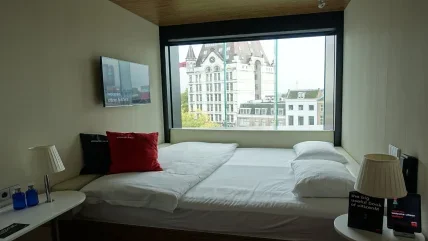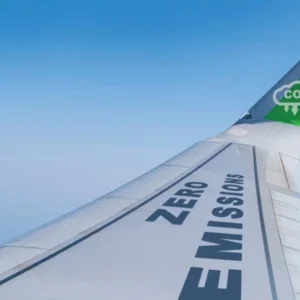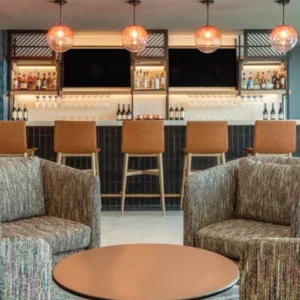
The no man’s land of time zones, where bleary-eyed travellers weary from long-haul flights cross paths with fresh-faced holidaymakers and business day-trippers alike: airports are places to pass through. No one wants to be there longer than necessary, yet sometimes a flight in the middle of the night or at the crack of dawn necessitates a stay at a runway-adjacent hotel. It is an unappealing prospect for most, who might expect a basic room illuminated by the white lights of the airstrip or sleep broken by the roar of jet engines. Yet, the latest airport lodgings show this not to be the case, using a multitude of clever design tactics to ensure that every guest sleeps well and starts the next day feeling relaxed, rejuvenated and ready for the journey ahead.
So, how does one create a haven within the hullabaloo of a busy airport? “The first thing to realise is that windows will not open; fixed windows keep out both noise and the smell of aviation fuel,” says Jonathan Manser, CEO of The Manser Practice, who worked on the interiors of the Heathrow Terminal 4 Hilton Hotel. “We created windows at each end of the atrium that are single sheets of glass, 2.4m apart, and used the air gap in between for heat recovery and as a thermal buffer. This results in no sound when jets go past the window as they take off.” Additionally, Manser stresses the significance of insulating the walls and roof of an airport hotel to control the level of noise heard from inside the guest rooms.
Maarten de Geus of Concrete Amsterdam, who led the design of citizenM’s hotels at Paris Charles de Gaulle Airport and Amsterdam Schiphol Airport, adds that it is important to consider internal noise as well, to ensure optimum sleep quality. “We even made sure the air circulation is very low in volume, so you don’t hear it,” he says.
Kaunteya Chitnis, the senior vice-president of acquisitions and development at MCR, the company that worked on the TWA Hotel at JFK New York, explains that when MCR conducted their research for the project they studied 34 different airport hotels. These studies were then cross-referenced with the complaints those hotels receive most often, alongside their proximity to the runways. “What we found was that noise complaints are one of the single biggest complaints at the airport hotel, and it’s almost a make or break if you can hear that airport traffic coming in and out,” he says. To combat this issue, MCR built the second-thickest curtain wall in the world, which completely blocks out the outside sound. “It’s a 4.5in-thick piece of glass, with seven layers of glass in between,” says Chitnis. This puts the TWA Hotel in the top 1% of the world’s hotels in terms of soundproofing.
Lighting can make or break the mood
Noise aside, another significant issue encountered by jet-lagged passengers is bright sunlight or the glare of neighbouring airports pervading the room. The first requirement to manage this matter, states Manser, is “good blackout curtains” to give sleep-deprived guests a well-deserved night of rest; and Chitnis agrees, having invested in high-quality blackout technology for the TWA Hotel. “The reason we did that was for the guests who come and go at all hours from the hotel and need a good night’s sleep,” Chitnis explains, “but also because we sell rooms for a day-stay of four hours, because there are so many layovers at JFK that people just need a place to sleep, get freshened up and head on to their connection.”
At citizenM, on the other hand, De Geus approached lighting each room “as though it was a black box”, taking out the factor of daylight and giving control over to guests so they can adjust the brightness of their room. The rooms come with panels that enable the guest to change the colour of the lights according to their mood, “so you can create the environment you want”, he explains. The standard setting is a light, fresh balance that is dimmable, but there are also fixed displays to suit various situations – whether the guest is watching a film, or waking up early in the morning. And although it can be difficult to create a striking facade when constructing an airport hotel (with height restrictions and rules placed on the materials that can be used), this smart use of different coloured lighting at citizenM’s hotel at Charles de Gaulle makes for a spectacular frontage through each of the windows come night-time.
Both Manser and De Geus focus on the ease of navigating an airport hotel as well: the front desk is opposite the front door, ready to greet guests at all hours; the lifts are visible and the route to the bedrooms is easy; and guests can find a place of refuge from the tumult of a busy airport. De Geus says: “The main thing is designing for a smooth stay, so guests don’t spend too much time checking in or finding their bedroom – it’s all about comfort and efficiency.”
Manser also points out that many people stepping off a long-haul flight may not speak the language of the country they are in, so clarity is key. “Pictogram signs are beneficial to weary travellers who may not know the local language,” he says. “For example, an image of a knife and fork indicating a restaurant, or a cocktail glass for a bar.”
The comfort of communal spaces is also far more important than one might expect – particularly when jet lag means that guests are unable to sleep and need somewhere other than their bedroom to unwind. De Geus describes an airport hotel as being “almost like an island” – a retreat from the busy airstrips outside – “so it’s very important to create public areas where you want to spend your time”. In order to make citizenM’s communal spaces home-like, Concrete Amsterdam sourced warm, darker fabrics for the lobby that contrasted with the fresh, white furnishings of the bedrooms.
Make the most of your location
While many airport hotels seek to escape the fact that they sit moments from the terminals, the TWA Hotel at JFK New York celebrates its prime position as the only hotel operating within the boundaries of JFK Airport. Set just moments from Terminal 5 and overlooking the bustling runway 4 left-22 right, interiors have been designed to reflect the building’s past as the 1962 Trans World Airlines Flight Center. It stopped being used as an air terminal in 2001, and in 2015 plans were drawn up for its new incarnation as a site of hospitality. “The building is gorgeous; it’s a developer’s dream, but it had its own complications,” says Chitnis.
Because the building is landmarked, MCR collaborated with 12 preservationists, 22 government agencies and 4,000 construction workers to bring their vision to life. “It’s a six-and-a-half-acre site in the middle of JFK Airport, the fifth busiest airport in the US, and it’s physically connected to Terminal 5 by a flight tube.” The original Flight Center was built by Eero Saarinen in 1962 and commissioned by Howard Hughes, who formed the terminal to accommodate a specific type of aircraft that he had built in 1958: the Lockheed Constellation L-1649. According to Chitnis, there are only four of these left in the world and MCR managed to track one of them down in Maine. “It is a beautiful propeller plane that had been abandoned, so we completely renovated it back to exactly how it would have looked in the 1960s and made it a cocktail bar.”
For Chitnis, the goal of the project was to create a sense of being transported back to the height of the Jet Age – and repurposing Hughes’ original aircraft this way was the cherry on top. “People can feel completely transported back to 1962 when they enter the building; we tried to really lean into that experience by giving people as much of that era as we could. For instance, in each of the 512 guestrooms there is a Western Electric 202 telephone that has a rotary dial, and they’re completely operational.” There is also an aviation history museum in the hotel for aircraft enthusiasts, who can even watch aircrafts take off and land from one of the 200, impressive 4x10m floor-to-ceiling windows.
The design of Heathrow Hilton also sought to appeal to aerophiles, opting for large glass panels that give an impressive panorama over the runways. “One of the challenges might well be an uninspiring view of hangars, so a more inward-looking hotel might be needed,” suggests Manser, “but at Heathrow, a view of the planes coming into land is rather exciting and adds to the drama of the hotel.” Drama is key for Manser: “Airport hotels should strive to have a little theatre about them,” he reveals.
While the experience at different airport hotels will vary, the fundamental approach to success remains the same. CitizenM, Hilton and the TWA Hotel understand that, for tired travellers, the convenience of location is not enough on its own to make a hotel a proper base – particularly when it’s up against the bright and brazen phenomenon of air travel.






